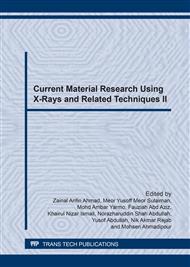[1]
X. Guo, Z. Wang, Effect of niobia on the defect structure of yttria-stabilized zirconia, J. Eur. Ceram. Soc. 18 (1998) 237-240.
DOI: 10.1016/s0955-2219(97)00123-4
Google Scholar
[2]
S. Raghavan, H. Wang, W. Porter, R. Dinwiddie, M. Mayo, Thermal properties of zirconia co-doped with trivalent and pentavalent oxides, Acta. Mater. 49 (2001) 169-179.
DOI: 10.1016/s1359-6454(00)00295-0
Google Scholar
[3]
H. Guo, X. Bi, S. Gong, H. Xu, Microstructure investigation on gradient porous thermal barrier coating prepared by EB-PVD, Scripta Mater. 44 (2001) 683-687.
DOI: 10.1016/s1359-6462(00)00646-1
Google Scholar
[4]
S. Raghavan, H. Wang, R.B. Dinwiddie, W.D. Porter, M.J. Mayo, The effect of grain size, porosity and yttria content on the thermal conductivity of nanocrystalline zirconia, Scripta Mater. 39 (1998)1119-1125.
DOI: 10.1016/s1359-6462(98)00290-5
Google Scholar
[5]
D.J. Kim, T.Y. Tien, Phase stability and physical properties of cubic and tetragonal ZrO2 in the system ZrO2–Y2O3–Ta2O5, J. Am. Ceram. Soc . 74 (1991) 3061-3065.
DOI: 10.1111/j.1151-2916.1991.tb04302.x
Google Scholar
[6]
E. Courtin, P. Boy, C.M. Rouhet, L. Bianchi, E. Bruneton, N. Poirot, C. Laberty-Robert, C. M. Sanchez, Optimized sol–gel routes to synthesize yttria-stabilized zirconia thin films as solid electrolytes for solid oxide fuel cells, Chem. Mater. 24 (2012).
DOI: 10.1021/cm302177s
Google Scholar
[7]
M.M. Bucko, Ionic conductivity of CaO-Y2O3-ZrO2 materials with constant oxygen vacancy concentration, J. Eur. Ceram. Soc. 24 (2004) 1305-1308.
DOI: 10.1016/s0955-2219(03)00502-8
Google Scholar
[8]
J. Brandon, R. Taylor, Phase stability of zirconia-based thermal barrier coatings part I. Zirconia-yttria alloys, Surface and Coatings Technology, 46 (1991) 75-90.
DOI: 10.1016/0257-8972(91)90151-l
Google Scholar
[9]
H. Scott, Phase relationships in the zirconia-yttria system, J. Mater. Sci. 10 (1975) 1527-1535.
Google Scholar
[10]
X. Guo, Physical origin of the intrinsic grain-boundary resistivity of stabilized-zirconia: role of the space-charge layers, Solid State Ionics, 81 (1995) 235-242.
DOI: 10.1016/0167-2738(95)00180-e
Google Scholar
[11]
X. Guo, Effect of Nb2O5 on the space-charge conduction of Y2O3 -stabilized ZrO2, Solid State Ionics, 99 (1997) 137-142.
DOI: 10.1016/s0167-2738(97)00147-1
Google Scholar


